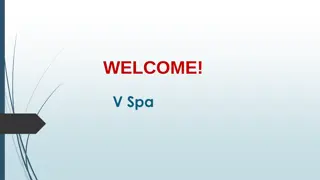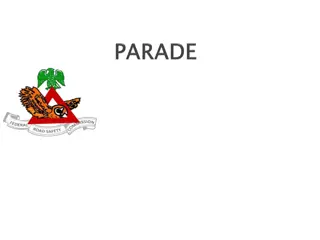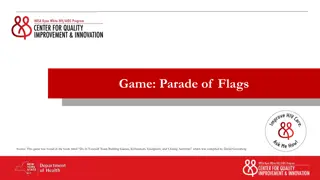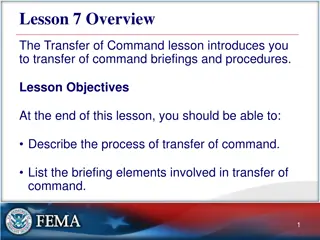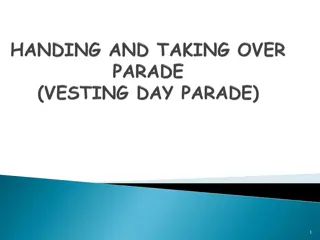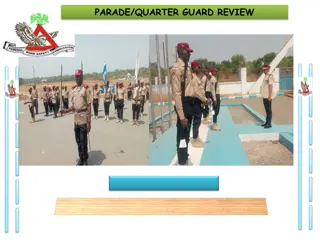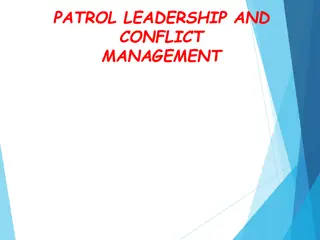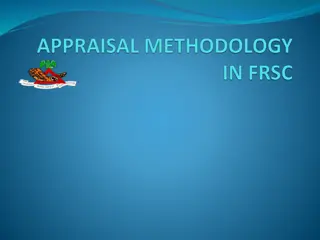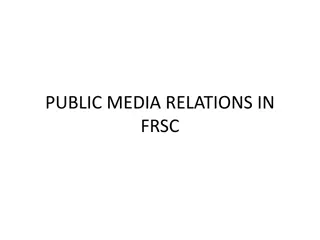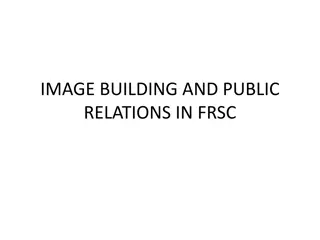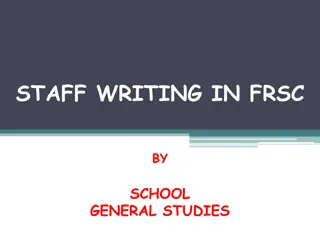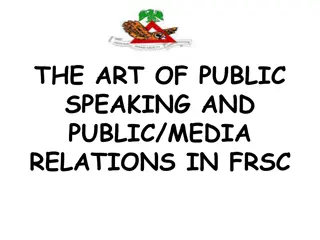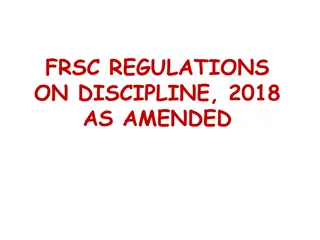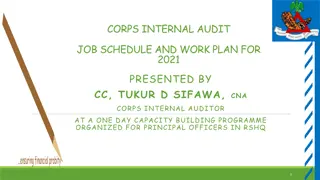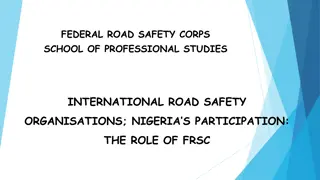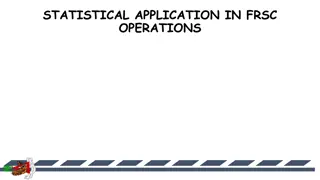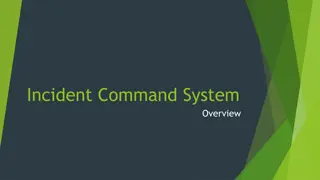Understanding Command and Control of Ceremonial Parade in FRSC
Military and paramilitary organizations execute official functions with discipline and uniformity, including ceremonial parades. This presentation explores the command and control aspects of ceremonial parades in settings like FRSC, covering definitions, aims, objectives, and the purpose of such parades. Participants will gain insights into terminology, parade execution, and the role of a parade commander.
Download Presentation

Please find below an Image/Link to download the presentation.
The content on the website is provided AS IS for your information and personal use only. It may not be sold, licensed, or shared on other websites without obtaining consent from the author. Download presentation by click this link. If you encounter any issues during the download, it is possible that the publisher has removed the file from their server.
E N D
Presentation Transcript
COMMAND AND CONTROL OF CEREMONIAL PARADE 1
Introduction 2 Military and paramilitary have been recognized for their distinctive pattern of organizing and executing official functions. This approach has brought to limelight the inherent disciplinary disposition and uniqueness of these settings in terms of regimentation and uniform performance. Amongst these performances are the manner cadets or trainees passed out from trainings, official weddings are conducted, burial of departed personnel, recognition of public functionaries, celebrating a retired personnel, exchange of pleasantries etc. However, the crux of this discourse would centre on the nitty-gritty of carrying out some ceremonial parade as obtained in regimented organizations like FRSC etc.
Aims 3 The aim of this presentation is to discuss the command and control of ceremonial parade for effective and efficient execution of this feat in FRSC.
Objective 4 After in-depth discourse of this, the participants would be able to: a. Explain some salient terms relating to ceremonial parade b. Know the purpose of ceremonial parade c. Acknowledge types of ceremonial parade d. Identify composition, timing and order of parade e. Imbibe the command procedure f. Appreciate characteristics of a parade commander
Definition Of Terms 5 In extrapolating the above subject, some related salient terms would be defined for better comprehension of the discourse. These are as follows: a. Drill: This consists of certain movements by which a unit or individual move in an orderly, uniform manner from one place to another. It is a regimented approach of memorizing or instilling certain desired traits or actions through repetition until the action is instinctive to the officer or marshal being drilled. c. Parade Commander: This is the person that commands parade. d. Alignment: A straight line on which a body of men is formed or is to form.
Definition Of Terms Cont. 6 e. Parade Ground: This is where staff regularly gather in formations or guards for inspection or training or regimented ceremonies like passing out parade or farewell (parade) amongst others. b. Ceremonial Parades: These are formations and movements in which a number of guards or staff executes movements in unison and with precision just as in drill and in commemoration or respect of public figure, event and/or achievements etc. However, their primary value is to render honors and stimulate esprit de corps.
Purpose Of Ceremonial Parade 7 Ceremonial parade is sustained and improved on regimented organization to attain the under listed purposes: a. To provide a means, through ceremonies, of enhancing the morale of Officers and Men, developing the spirit of cohesion, and presenting traditional, interesting and well-executed parades. b. To boost the pride, dignity and sense of belonging of Officers and Men c. To maintain as well as improve on the respect and unique pattern of long held traditions and ethics d. To aid in disciplinary training by instilling habits of precision and response to the leader s orders.
Types Of Ceremonial Parades Ceremonial parade pattern varies in view of the specific occasion it is organized for. The following are the types ceremonial parades: 8 1. PASSING OUT PARADE. 2. INDEPENDENCE/ ANNIVERSARY PARADE. 3. WEDDING CEREMONIES. 4. PULLING OUT PARADE. 5. BURIAL/FUNERAL PARADE. 6. HANDING AND TAKING OVER PARADE.
Passing Out Parade Passing out Parade is conducted in training institutions to mark the end of training for a set of cadets or men respectively. It involves the cadets and marshals marching pass and taking their oath of commission or attestation as the case may be. In this parade guards are formed due to availability of cadets. The composition of each guard is 48 cadets or Marshals and 3 Officers (one Guard commander and 2 sub- Guard commanders). The parade usually has guards in even numbers of 2, 4, 6 or 8. 9
Sequence Of Formation During Passing Out Parade Falling in/ form up of parade by RSM. 10 Numbering, sizing and checking of parade by RSM. The flag bearers will join the parade in the front. The band will take position in front of the flag bearers facing the direction the parade is to march. The RSM will march in the cadets/trainees into the parade ground. RSM will halt and advance the parade to face him. The cadets/trainees will form two ranks from three ranks. The cadets/trainees will take dressing from the right hand maker. The RSM will stand the cadets/trainees at ease while waiting for the arrival of the 2i/c to Adjutant to take over the parade. The RSM will call the cadets/trainees to attention and proceed to hand over the parade to the 2i/c. after handing over; the RSM will march to take post with the colour party outside the parade ground.
Sequence Cont 11 The 2i/c Adjutant will draw his sword and March forward to take his position in front of the parade. Thereafter, he halts and turns about to face the saluting dais. He will also stand the cadets/trainees at ease. The Bugle is sounded for the Guard and sub-Guard commanders to fall in and take their rightful positions. After the Bugle, the parade 2i/c Adjutant calls the parade to attention. Thereafter the Guard and sub-Guard commanders march to the edge of the parade ground, turn to the right facing the parade, halt and stand at ease. v The parade 2i/c Adjutant commands the Guards and sub-Guards commanders to fall into their guards. They will now assume the position of attention and draw their swords with the assistance of the side drummer who will time their actions. Having assumed their positions in front of their guards, they halt, turn about then take their dressing. The parade 2i/c then stands the whole body of parade at ease . v The parade Adjutant will approach the parade ground, the 2i/c calls the parade to attention and marches forward to hand over the parade to the parade Adjutant. The parade Adjutant takes over the parade but allow the 2i/c to march back and fall in at the extreme left of the parade beside the last guard
Sequence Cont. 12 The parade Adjutant draws his sword and march forward to take his position in front of the parade, turns about and faces the saluting dais. The parade Adjutant commands the ensign to the colour to march-on the colours . The parade remains at attention as the colour march on, while the Adjutant, 2i/c and other Guard and sub-Guard commanders flash their swords to salute the colours. The colour party marches into the parade ground and take position at the centre half of the parade. The Ensign to the colour commands the escort to the colour to salute. The parade Adjutant commands the Guard and Sub- Guard commanders to return their swords to carry position. The Adjutant commands the Ensign to the colour to take post in line with the sub-guard commanders.
Sequence Cont 13 Ensign to the colour marches the colour party to align at the centre of the guards. As the Parade Commander approach the parade ground, the Adjutant calls the parade to attention and marches forward to handover the parade to the parade commander. The Adjutant turns to the right and marches off to take post at the extreme right of the parade beside number one (1) guard. The cadets overall parade commander now takes charge of the parade by asking the parade to stand at ease . While awaiting the arrival of the Reviewing Officer, the band may be invited to play some background music. The Reviewing Officer on his arrival will inspect the Quarter Guard mounted before proceeding to the parade ground. On arrival of the Reviewing Officer, he will mount the saluting dais and funfair will be rendered by the band. Thereafter, the parade commander will call for General/National salute to be rendered for the Reviewing Officer depending on his status or who he is representing. This is done while the parade is at attention.
Sequence Cont The parade commander marches forward to the Reviewing Officer, halts, salutes and invites him to inspect the parade. He then turns to the right, halts and waits for the Reviewing Officer to come down from the saluting dais. He then leads the Reviewing Officer together with the commandant flanked by flag bearers to inspect the parade starting from the right flank of the parade. 14 Inspection over, the parade Commander asks for the permission of the Reviewing Officer to carry on with the parade. When the permission is granted, the parade commander will salute and march to assume his position in front of the parade while the Reviewing Officer returns to the saluting dais still flanked by the flag bearers. After the inspection of the parade, the parade commander will give the guards the command Form 3 ranks from 2 ranks, form 3 ranks 3 ranks will be formed. The parade will march past in slow and quick time. Thereafter, they will halt and take dressing from the centre
Sequence Cont The parade will advance in review order by taking 14 marching paces. The body of the parade will halt at 10 paces to the Reviewing Officer and are commanded to stand at ease by the parade commander. Thereafter, there will be presentation of awards to deserving cadets/trainees followed by speeches. Speeches are usually brief. Prayers will be rendered by the chaplain or imam for the cadets. The parade gives three hearty cheers to the Reviewing Officer. The parade Commander calls for either National salute or General Salute after which he seeks the permission of the Reviewing Officer to pass out the cadets/trainees. The parade then forms two ranks from three ranks. They take inward dressing. The parade commander then commands the colour party to take post. The colour party will take five marching paces and halts. The parade commander will now command the body of the parade to turn inward. The band will play funfair and a solemn tune bidding the cadets farewell from the Academy. The cadets file out in slow march. On approaching the salute dais, the cadets will salute the reviewing officer by turning their faces inwards in the direction of the Reviewing Officer. The Guard and Sub-Guard commanders will follow and Band will be the last to file out from the parade ground. 15
Independence Parade 16 The Independence Day parade is to commemorate the National independence anniversary day which is held on the 1st October yearly. FRSC do participate in this parade in conjunction with other military and paramilitary organizations. The composition, timing and order of parade are same as that of Passing out Parade just with more Guards due to availability of officers. But the parade is always commanded by a military officer where there is a military formation otherwise will be commanded by a police officer especially at the state level where there is no military formation.
Ceremonial Wedding 17 It is customary in regimented organizations for a parade to be organized for a staff (both Officers and Marshals) that is wedding. Specifically, swords are crossed for commissioned Officers. The least numerical strength of sword party members is twelve (12) who formed in file, but still more officers could participate based on their availability. Crossing sword for officers gains it origin from past practice wherein sword was integral outfit of only officers. However, Officers still adorn themselves with swords only on ceremonial occasion when needs arise. This occasion is carried either at Church, Mosque, and Court Registry or at the reception ground. The sword is presented to the celebrant at the reception ground for the cutting of the cake. This is done on behalf of the President C-in-C as a symbol to commemorate the wedding and for the protection of the wife. The presentation of the sword should be done by an officer of equal rank and seniority or subordinate to the Officer wedding. Note that sword is not crossed for Marshals.
Ceremonial Wedding Cont. 18 Arrival of the Groom: The Sword party must have formed up in two ranks facing each other inwardly awaiting the arrival of the groom at the entrance of the event venue. As the groom alight and stand by the Officers on parade, a funfair would be played by the band. Thereafter, the parade commander would call the parade to attention, removal of sword from the scabbard and General salute word of command will be given by the parade commander where they will salute the groom in which the groom would respond by saluting when the sword is flashed and bringing down his when it is at carry position.
Ceremonial Wedding Cont. 19 Inspection of the Parade: This is done by the leadership of the sword party commander who advances from the body of the party to welcome the groom and render the party status. Thereafter, guides the groom in inspecting the turn out of the party members starting from the first member on the left rank and leading to right rank and ending with last on the right rank. Thereafter, he would take permission to carry on with the parade. In all this, the commander s sword is at carry position Marching in the Groom: Here Officers will march in two ranks, into the church in slow time, as they escort the groom. The groom and his best man leading. This is done in view of sword party commander s command. Note: head dress or gear must be removed with the right hand to be held with the left hand with crest facing front. As they get close to the pulpit or where the groom would sit during the event, the groom and his best man take their seat while others turn outward or inward depending the seating pattern of the venue; and march out from the venue.
Ceremonial Wedding Cont. 20 Marching in the Bride: This is entirely civil in which the bride would be accompanied in by her friends and family members to take her seat after the groom must have taken his, awaiting her arrival. Stepping out of the Event Venue: At this juncture, it is believed that they must have been joined together in holy matrimony. The husband would come holding the wife with his left hand, closely behind them is his body guard and the wife s chief bridesmaid and other well-wishers. They will all march out in slow time as the band plays.
Ceremonial Wedding Cont. Crossing of Sword: The party members come out from the venue earlier and form two ranks inwardly in front of the venue with their sword at carry position at the command, Officers we or will draw sword, draw sword! When the groom comes out, position himself and put on his head dress with his body guard; funfair would be played by band. After the command: General Salute, Salute! At this, the members would salute and the groom response appropriately saluting. Thereafter, the party member would return to carry position at the command carry! As usual the groom would cut down his hand to attention position. Then, at the command Officers will cross swords, cross swords! As the sword is crossed the band plays the slow time and the bridal train march under it to a distance. They will halt and turn about facing the party to the church direction. By the command, parade will return sword, return sword! Here the swords are brought to the carry position and returned to the scabbard as in sword drill. Note: the crossing is meant for the bridal train only. 21
Ceremonial Wedding Cont. 22 Congratulatory Salutation: Here, the commander would issue the command, congratulatory salute, right and left turn! In response, the right rank would turn to left as those on left would turn to right all facing the couples. The first officer on the right from the church takes a pace forward, turns to the right and march in quick time, swinging only the right arm, as the left hand is holding the scabbard. Halt in front of the husband and salute, take a pace forward shakes and congratulates him. He takes a pace backward, salute and takes post by his side remaining at attention. Also the officer opposite him takes pace forward as soon as the congratulating officer takes a pace backward, and continues the exercise, the second officer, this time form up by the side of the wife and remain at attention. Note: the right rank falls by the husband and the left rank falls by the wife, the bridal train is now brought to the front of the celebrant for a group photograph. Also, note that during the photograph, the two makers by the husband and wife draw and cross their sword putting the celebrants at the centre, while others form a semi-circle with their swords still remain in the scabbard.
Ceremonial Wedding Cont. 23 Falling Out: At the command, a pace forward March, officers turn to the right and salute, fall out! The officers alone take a pace forward, turn to the right and salute, at the same time the husband receives the salute and they march out in quick time. Procedure at reception ground: The following activities are carried out at the reception venue: The Band Positioning: The bandsmen will be placed in the reception hall where they can see all the actions and always play the fanfare as the members of the high tables are being appointed. Marching in of the Celebrant: The sword party members would strategically position themselves in two ranks inwardly awaiting the arrival of the couple. At the arrival, sword would be drawn and maintained at carry position at the commander s command. General Salute would be offered as the groom is expected to salute appropriately. Thereafter, the Couple would be marched into the venue as was done at the wedding venue.
Ceremonial Wedding Cont. Presentation of sword: It is customarily expedient that the sword is used in cutting the wedding cake. To this end, the commander now presents the sword of honour to the husband, who has come out and stood in front of the cake. The commander with two escorts will advance in slow time, with their sword at the carry position. They halt in front of the husband and salute, then the commander takes a pace forward and say the presidential message as follows: 24 This is the beginning of victory, great battles have been fought and won by the use of sword, officers are known by the sword they carry, I ---------- on behalf of president & commander-in- chief Federal Republic of Nigeria, hereby present this sword of honour on this great occasion of your wedding though weapon, it shall be used for the cutting of your wedding cake and thereafter for the defence of your beautiful wife. Congratulations Sir! Then present the sword to the husband, who returns it to body guard who slot it in the husband scabbard and salute. Note: their hands will remain there until the fanfare is over during receiving of sword. The commander now draws his sword, kiss and retain and take a pace backward to align with his escort and salute. Finally, they all turnabout, march out in quick time and halt, turn the right in single file and salute to dismiss.
Ceremonial Wedding Cont. 25 Cutting of the Cake: The cake is cut with sword and hands remain there until the fanfare is over Feeding of Couples: Here the fanfare must play for the feeding of the husband alone, but for the bride, the side drums can be tapped. Note that the husband feeds the wife first. Dancing with the Husband: After the celebrants must have opened the floor by dancing with other relatives as the M/C may deem necessary, there must be a special dance called Ball Room Dancing , this is only for the officers and celebrants. Note that all officers present will come out dance without their head dress as stipulated in contemporary system. Presentation of Gifts: The groom would strategically position himself and receives gifts and hand over to the body guard for safe keeping. During this, the husband salutes and shake hand with his colleagues but only offer hands shake to civilians. Dispersal: After presentation of gifts and dance, it is believed that the event has come to an end officially; all other functions as designed, then the Officers can now depart.
Pulling Out Parade: 26 Pulling out parade is also known as farewell parade and it is held at the instance of retiring senior Officers who have served the nation meritoriously. These classes of senior Officers are pulled out as a sign of respect and final farewell from the service. This is done immediately after the farewell parade. The composition of this parade is made up of both Officers and Marshals. The Officers will act as Guard and sub-Guard commanders. This parade takes the exact pattern of a Passing out Parade except that the body of the parade will be formed by Marshals only and slight changes after the Reviewing Officers address. They as follows. v The parade commander will assume attention position, command the parade to attention and give general salute. After the salute, the parade commander marches towards the Reviewing Officer to seek permission to carry on with the parade. Thereafter, the parade commander, guard and sub-guard commanders will flash their swords in honour of the colour party as they step out from the parade ground.
Pulling Out Parade Cont. The parade commander will command the parade to march past in COLUMN OF ROUTES . The parade then turns to the right and halt. The parade commander, guard and sub- Guard commanders take position. The band moves to the front of the parade and halt. The parade commander will give the command BY THE RIGHT QUICK MARCH . The band leads and they all march past in front of the saluting dais and salute the Reviewing officer and march off. After the parade, a Land Rover with rope tied to the front will be driven to the front of the parade where senior officers subordinate to the Officer being pulled out will form up with the most senior who will command the pulling will stand at the front(right) and command the Officers to pick up rope. The Officer being pulled out together with his spouse will enter the open Land Rover and the senior officer on the right of the parade will command the parade to march in slow time. They will now pull him till they get out of the gate of the premises. They will be escorted by the band. 27
Burial/Funeral Parade 28 Funeral parade is organized in honour of the deceased serving personnel. All ranks are to wear uniform. The national flag and FRSC flag will be over the coffin and prior to interment will be folded in triangular shape and presented to the chief mourner who will in turn present it to the next of kin. The head dress, belt, sword and boots of the deceased should be placed on the coffin in addition to wreaths. The burial party will consist of an Officer, senior non commissioned officer or Non commissioned officer in charge and six to eight bearers depending upon circumstances. The rank of the bearers will depend upon the rank of the deceased. Where these ranks are not available, junior ranks next to the rank of deceased may be used. All ranks passing a military or paramilitary funeral will salute the bier. Burial party may consist of 6-8 persons to arrive at the mortuary. The chief mourner receives the body from the hospital authority and hands over the coffin to the burial party commander. The commander calls the burial party to attention. They march forward, carries the coffin and lowers it into the waiting ambulance. NOTE: Where necessary, the deceased may be brought to the office for members of the command to pay last respect.
Burial/Funeral Parade Cont. 29 At the office, all officers and men must be on ground to receive the deceased and where necessary, a black arm band may be worn on the left hand to denote mourning. The FRSC flag is flown at half-mast. Officers and marshals will form up in an open place or parade ground in the command where a table must have been provided for the burial party to place the coffin. The burial party gently removes the coffin from the ambulance and place on their shoulder and marches in slow time. Members of the burial party on the right will take right leg while those on the left will take left leg on the command slow march . Prayer session is to be offered in line with the religious belief of the deceased. Immediately after the prayer, the commanding Officer moves to the Quarter Guard to pay his last respect
Burial/Funeral Parade Cont. The biography of the deceased may be read. All marshals of the command will fall in in file facing each other from the casket towards the quarter guard. Officers will form up in a single file, move round the deceased, observe it, bow their heads and pay their last respect by saluting regardless of the deceased rank. The burial party marches forward, carries the casket and puts it inside the ambulance. The ambulance moves slowly through the formed bodies of men and as the ambulance approaches them, each pair of staff facing each other come to attention and salute. At the quarter guard, the ambulance stops and the burial party marches forward and bring out the casket, place it on a table and open it. The commanding officer will observe it and pay last respect by saluting regardless of the deceased rank. Afterwards, the burial party will carry the casket back into the ambulance and it drives away to the place of interment. (The ambulance will be in front and next will be the vehicle conveying the next of kin/immediate family or chief mourner). This ends the office procession where observed. 30
Burial/Funeral Parade Cont. 31 The burial party will march with the coffin on their shoulder into the church (where allowed), place it on the table and also carry it out immediately after the service into the ambulance to the burial ground. At the grave side, the burial party will remove the deceased from the ambulance, place the remains by the grave side and allow all necessary religious rites and traditions of the deceased to be observed. Where allowed, the burial party may assist the family to lower the deceased into the grave. Immediately the body is lowered into the grave, the burial party commander calls the party to attention and a farewell bugle will be played signifying the end of the burial. The burial party will march off in quick march. The burial party commander before interment will remove the cap, belt, sword, shoes and the national flag from the top of the coffin and present them to the chief mourner who in turn presents them to the next of kin. The National flag will at this point be folded in triangular shape before being presented.
Handing And Taking Over Parade: 32 This is otherwise known as vesting day parade which is conducted to mark the end of leadership of a commanding Officer in a command and the commencement of a new one. For vesting day parade, a parade of not less than two guards forms up at the parade ground. RSM hands over the parade to the parade 2i/c who commands the Officers to fall in. The guard and sub-guard commanders take their positions in front of the guards and observe their dressing. The 2i/c hands over the parade to the parade commander and 2i/c marches off and takes his position in guard one. The parade commander calls the colour party to march in, the colour party marches in, take their position and observe their dressing in line with the body of the parade.
Handing And Taking Over Parade Cont. 33 Arrival of the senior Officers of the command, the in-coming Commanding Officer and out-going Commanding Officer who will serve as the special Guest of Honour, and also inspect the Quarter Guard. The out-going Officer will mount the saluting dais while general salute will be -rendered. He inspects the parade. Where it can be accommodated, the parade may march past in slow and quick time. Thereafter, they will advance in review order and the out- going Commanding Officer will give his farewell address and thereafter he will retire to take his seat at the VIP stand. The in-coming Commanding Officer will give his own address mainly on his style of leadership and what he intends to achieve in the command. Immediately after his address, he will retire to the VIP stand.
Handing And Taking Over Parade Cont. 34 The table party will march in with the table to the front of saluting dais. The out-going and in-coming commanding Officers will sit on the chairs provided at the table and sign the handing and taking over note while the principal Officers of the command witness. Thereafter, the table party marches in and remove the table from the parade ground. The flag/colour of the command and where the command does not have its own separate colour; the FRSC flag may be used. The flag will be marched to the parade ground. (This is not colour party). The Officer carrying the flag will present it to the out-going Commanding Officer who will in turn present it to the in-coming commanding Officer. The out-going commanding Officer returns to the saluting dais to receive THREE HEARTY CHEERS . After this, general salute will be rendered and then the parade commander will march towards him and take permission to carry on with the parade. Then the parade march out in column of
Characteristics Of A Parade Commander. 35 A parade commander should possess the following characteristics: 1. A parade commander must have a good understanding of parade. 2. A parade Commander should be highly regimented. 3. Skilled in commanding parade and inspiring presence. 4. Possess an exceptional marching technique. 5. His vocal are loud and easily understood. 6. Highly responsible and reliable. 7. A team player. 8. A highly focused Officer. 9. A teacher and a teachable spirit.
CONCLUSION. 36 It is quite imperative for all cadets to learn these parades and also Officers of the Corps to refresh their minds with the sequence of mounting and inspection of Quarter Guard. Passing out Parade is highly a regimented parade that all officers ought to be proud to have participated in. All should be knowledgeable in its sequence as any officer can find himself reviewing a passing out parade in another Uniform organization.
37 THANK YOU FOR LISTENING!!




